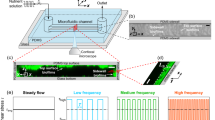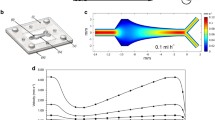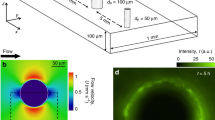Abstract
The appearance of highly resistant bacterial biofilms in both community and hospitals environments is a major challenge in modern clinical medicine. The biofilm structural morphology, believed to be an important factor affecting the behavioral properties of these “super bugs”, is strongly influenced by the local hydrodynamics over the microcolonies. Despite the common use of agitated well plates in the biology community, they have been used rather blindly without knowing the flow characteristics and influence of the rotational speed and fluid volume in these containers. The main purpose of this study is to characterize the flow in these high-throughput devices to link local hydrodynamics to observed behavior in cell cultures. In this work, the flow and wall shear stress distribution in six-well culture plates under planar orbital translation is simulated using Computational Fluid Dynamics (CFD). Free surface, flow pattern and wall shear stress for two shaker speeds (100 and 200 rpm) and two volumes of fluid (2 and 4 mL) were investigated. Measurements with a non-intrusive optical shear stress sensor and High Frame-rate Particle Imaging Velocimetry (HFPIV) are used to validate CFD predictions. An analytical model to predict the free surface shape is proposed. Results show a complex three-dimensional flow pattern, varying in both time and space. The distribution of wall shear stress in these culture plates has been related to the topology of flow. This understanding helps explain observed endothelial cell orientation and bacterial biofilm distributions observed in culture dishes. The results suggest that the mean surface stress field is insufficient to capture the underlying dynamics mitigating biological processes.


















Similar content being viewed by others
References
Abelson, A., and M. Denny. Settlement of marine organisms in flow. Annu. Rev. Ecol. Syst. 28:317–339, 1997.
Azevedo, N. F., A. R. Pinto, N. Reis, C. W. Keevil, and M. J. Vieira. Shear stress, temperature and inoculation concentration influence on the adhesion of water-stressed Helicobacter pylori to stainless steel 304. Appl. Environ. Microbiol. 72:2936–2941, 2006.
Berson, R. E., M. R. Purcell, and M. K. Sharp. Computationally determined shear on cells grown in orbiting culture dishes. Adv. Exp. Med. Biol. 614:189–198, 2008.
Bryers, J. D. Medical biofilms. Biotechnol. Bioeng. 100:1–18, 2008.
Byrd, J. J., and T. M. Powledge. The Complete Idiots Guide to Microbiology. New York: Alpha, pp. 197–201, 2006.
Chen, M. J., Z. Zhang, and T. R. Bott. Effects of operating conditions on the adhesive strength of Pseudomonas fluorescens biofilms in tubes. Colloids Surf. B 43:61–71, 2005.
Dardik, A., L. Chen, J. Frattini, H. Asada, F. Haziz, F. Kudo, and B. Sumpio. Differential effects of orbital and laminar shear stress on endothelial cells. J. Vasc. Surg. 41(5):869–880, 2005.
Donlan, R., and J. Costerton. Biofilms: survival mechanisms of clinically relevant microorganisms. Clin. Microbiol. Rev. 15:167–193, 2002.
Fluent Manual, Fluent 6.3 FLUENT Inc., 2006.
Greenspan, H. P., and L. N. Howard. On a time-dependent motion of a rotating fluid. J. Fluid Mech. 17:385–404, 1963.
Greenspan, H. P. On the general theory of contained rotating fluid motion. J. Fluid Mech. 22(3):449–462, 1965.
Haga, M., A. Yamashita, J. Paszkowiak, B. E. Sumpio, and A. Dardik. Oscillatory shear stress increases smooth muscle cell proliferation and Akt phosphorylation. J. Vasc. Surg. 37(6):1277–1284, 2003.
Hopfinger, E. J., F. K. Browand, and Y. Gagne. Turbulence and waves in rotating tanks. J. Fluid Mech. 125:505–534, 1982.
Hopfinger, E. J., and G. J. F. van Heijst. Vortices in rotating fluids. Ann. Rev. Fluid Mech. 25:241–289, 1993.
Kostenko, V., M. M. Salek, P. Sattari, and R. J. Martinuzzi. Staphylococcus aureus biofilm formation and tolerance to antibiotics in response to oscillatory shear stresses of physiological levels. FEMS Immunol. Med. Microbiol. 59:421–431, 2010.
Kraiss, L. W., A. S. Weyrich, N. M. Alto, D. A. Dixon, T. M. Ennis, V. Modur, T. M. McIntyre, S. M. Prescott, and G. S. Zimmerman. Fluid flow activates a regulator of translation, p70/p85 S6 kinase, in human endothelial cells. Am. J. Physiol. Heart Circ. Physiol. 278:H1537–H1544, 2000.
Ley, K., E. Lundgren, E. M. Berger, and K.-E. Arfors. Shear-dependent inhibition of granulocyte adhesion to cultured endothelium by dextran sulfate. Blood 73:1324–1330, 1989.
MacLeod, S. M., and D. J. Stickler. Species interactions in mixed-community crystalline biofilms on urinary catheters. Med. Microbiol. 56(Pt 11):1549–1557, 2007.
Meda, M. S., A. J. Lopez, and A. Guyot. Candida inferior vena cava filter infection and septic thrombophlebitis. Br. J. Radiol. 80(950):e48–e49, 2007.
Murray, T. S., M. Egan, and B. I. Kazmierczak. Pseudomonas aeruginosa chronic colonization in cystic fibrosis patients. Curr. Opin. Pediatr. 19(1):83–88, 2007.
Percival, S. L., and P. G. Bowler. Biofilms and their potential role in wound healing. Wounds 16:234–240, 2004.
Phillips, P. L., E. Sampson, Q. Yang, P. Antonelli, A. Progulske-Fox, and G. Schultz. Bacterial biofilms in wounds. Wound Healing South Afr. 1:10–12, 2008.
Presterl, E., A. Lassnigg, M. Eder, S. Reichmann, A. M. Hirschl, and W. Graninger. Effects of tigecycline, linezolid and vancomycin on biofilms of viridans streptococci isolates from patients with endocarditis. Int. J. Artif. Organs 30(9):798–804, 2007.
Purevdorj, B., J. W. Costerton, and P. Stoodley. Influence of hydrodynamics and cell signaling on the structure and behavior of Pseudomonas aeruginosa biofilms. Appl. Environ. Microbiol. 68:4457–4464, 2002.
Salek, M. M., S. Jones, and R. J. Martinuzzi. The influence of flow cell geometry related shear stresses on the distribution, structure and susceptibility of Pseudomonas aeruginosa 01 biofilms. Biofouling 25:711–725, 2009.
Sattari, P. Design and Fabrication of an Optical Non-intrusive Shear Rate Sensor. M.Sc. Thesis, Department of Mechanical and Manufacturing Engineering, University of Calgary, 2008.
Sherman, F. S. Viscous Flow. New York: McGraw-Hill, pp. 140–141, 1990.
Sillankorva, S., P. Neubauer, and J. Azeredo. Pseudomonas fluorescens biofilms subjected to phage phiIBB-PF7A. BMC Biotechnol. 8:79, 2008.
Simões, M., M. O. Pereira, S. Sillankorva, J. Azeredo, and M. J. Vieira. The effect of hydrodynamic conditions on the phenotype of Pseudomonas fluorescens biofilms. Biofouling 23:249–258, 2007.
Simões, M., M. O. Pereira, and M. J. Vieira. The role of hydrodynamic stress on the phenotypic characteristics of single and binary biofilms of Pseudomonas fluorescens. Water Sci. Technol. 55:437–445, 2007.
Sousa, C., M. Henriques, J. Azeredo, P. Teixeira, and R. Oliveira. Staphylococcus epidermidis glucose uptake in biofilm versus planktonic cells. World J. Microbiol. Biotechnol. 24:423–426, 2008.
Stoodley, P., I. Dodds, J. D. Boyle, and H. M. Lappin-Scott. Influence of hydrodynamics and nutrients on biofilm structure. J. Appl. Microbiol. 85:S19–S28, 1999.
White, F. M. Fluid Mechanics (6th ed.). New York: McGraw-Hill, pp. 164–166, 2008.
Wilson, D. W., J. A. Scalf, S. Forouhar, R. Muller, F. Taugwalder, M. Gharib, D. Fourguette, and D. Modarress. Diffractive optic fluid shear stress sensor. In: Trends in Optics and Photonics, Diffractive Optics and Micro-Optics, Vol. 41, edited by T. Li. Washington, DC: Optical Society of America, 2000, pp. 306–308.
Youngs, D. L. Time-dependent multi-material flow with large fluid distortion. In: Numerical Methods for Fluid Dynamics, edited by K. W. Morton, and M. J. Baines. New York: Academic, 1982.
Acknowledgments
The authors recognize valuable discussions with Dr. Victoria Kostenko. M. Mehdi Salek would like to acknowledge Alberta Ingenuity Fund (AIF), now part of Alberta Innovates Technology Futures for their support through a scholarship. This research has been enabled by the use of computing resources provided by WestGrid and Compute/Calcul Canada.
Author information
Authors and Affiliations
Corresponding author
Additional information
Associate Editor Konstantinos Konstantopoulo oversaw the review of this article.
Rights and permissions
About this article
Cite this article
Salek, M.M., Sattari, P. & Martinuzzi, R.J. Analysis of Fluid Flow and Wall Shear Stress Patterns Inside Partially Filled Agitated Culture Well Plates. Ann Biomed Eng 40, 707–728 (2012). https://doi.org/10.1007/s10439-011-0444-9
Received:
Accepted:
Published:
Issue Date:
DOI: https://doi.org/10.1007/s10439-011-0444-9




